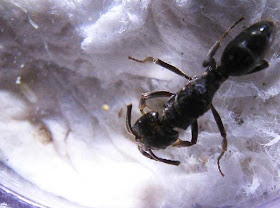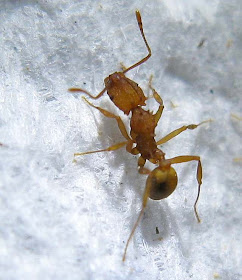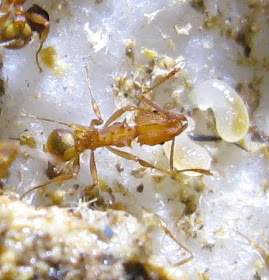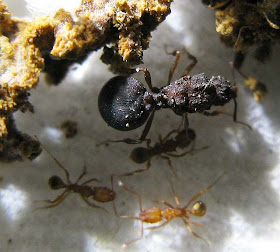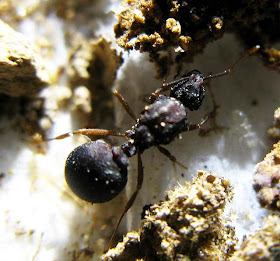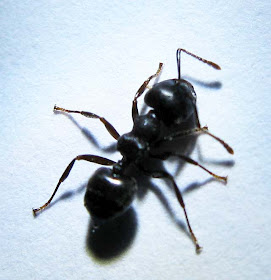This common black ant is an effective predator of small insects. It is a very common ant found almost everywhere where there are any small strips of vegetation even beside pavement and buildings.
Mainly solitary hunters of small prey (arthropods of about its size or smaller) they also participate in group attack on exposed nest of other ants. They are the main competitor to the Diacamma genus.
Odontoponera transversa (jnr. synonym O. denticulara) rarely use their stings which seemed to be reserved for their battle with other ants of similar size. They have a very effective bite as is evident in the shape and teeth of their mandibles.
Similar with many species of Ponerinae ants, some Odontoponera workers are able to lay eggs even if they never mated.
Odontoponera transversa queen are what I call 'hunter mamas'. The dealate gyne hunts for food for her first brood and does not seal herself into the security of her nest (is semi-claustral) while waiting for her first batch of workers to mature. Typical of most ants, Odontoponera, swarms after dark usually followed on a rainy spell. The gyne are almost the same size as the workers and the easily observable feature is her slightly thicker thorax. In the workers the thorax tapers towards the 'waist' joining the gaster. Ant keepers see bottom of page for details to acquire and raise a Odonponera denticulata queen.
Odnontoponera denticulata are among some species of ants that have, what I call 'slippery feet'. Their legs are unable to grip onto smooth surfaces like smooth glass, stones, etc.
Nest opening of Odontoponera transversa.
Nest opening of Odontoponera denticulata.
An Odontoponera ant dragging a Macrotermes malaccensis major soldier.
An Odontoponera transversa worker.
An Odontoponera denticulata worker.
An Odontoponera transversa worker.
The Queen.
A new gyne of Odontoponera denticulata with her first egg (left)
The Odontoponera transversa queen.
The Odontoponera dentriculata queen.
The Brood.
Odontoponera transversa queen with her first brood.
Odontoponera denticulata gyne are hunter queens in that a dealate gyne hunts and forages for food while awaiting the maturing of her first brood of workers.
The larvae feeding on a juicy drumstick of cricket.
Close-up of a young larva.
Nest of Odontoponera transversa.
Workers of Odontoponera transversa has a unique way of bringing water back to the nest. They roll the water in a water bubble as shown in this series of photos.
Odontoponera transversa worker collecting water for the larvae by rolling water into a small bubble ball.
The water is meant for the larvae when the weather is very dry and the earth nest dries out. Apparently this species does not regugitate food or water to feed the brood.
Ant Keepers Guide To Odontoponera Transversa.
Last Updated: 2018 01 01
First Posted: 2009 10 30
© 2009 – 2014 Quah. All rights reserved.
The nuptial swarming of Odontoponera transversa takes place at dusk and into the night. Like all late evening to night swarmers the alates are attracted to light sources so if you are living in the city it would be pretty difficult to track down a mated queen due to the high dispersion factor. But if you live close to the ground in semi urban areas and these ants are quite common, leaving your windows open and lights on during their nuptial swarmings will most likely see some dealated gyne running on the floor. This ants has slippery feet and cannot climb smooth surface.
Being a hunter queen there is also a chance to retrieve a mated queen especially in the morning, evening and night time if you hunt for them with a torch. The newly mated queen will forage for food mostly at night for up to period of over a month after her mating. This she does to provide food for her growing brood.
If you acquire a mated gyne you will need to feed her protein food regularly while she raise her first brood of workers. Without food she will not lay eggs and will die after several days. Unlike carpenter ants which can tolerate a fairly high humidity level, Odontoponera transversa cannot and will most probably drown if the humidity in an enclosed or semi sealed environment is too high.
Food during the founding stage of the colony preferably are insects and other arthropods. Food should be of sizes that a lone queen can easily handle. If feeding large insects or arthropods be sure to cut into manageable sizes or mesh them up for the founding queen.
Though in a mature colony, workers will take food from most protein source including raw or cooked meat of chicken, beef, prawns, etc., however during the founding stage the queen prefer insects and other arthropods (including their eggs, larvae and pupae).
A founding queen and her first brood of workers
Food during the founding stage of the colony preferably are insects and other arthropods. Food should be of sizes that a lone queen can easily handle. If feeding large insects or arthropods be sure to cut into manageable sizes or mesh them up for the founding queen.
Though in a mature colony, workers will take food from most protein source including raw or cooked meat of chicken, beef, prawns, etc., however during the founding stage the queen prefer insects and other arthropods (including their eggs, larvae and pupae).
Taxonomy
Kingdom - Animalia
Phylum - Arthropoda
Subphylum - Hexapoda
Class - Insecta
Subclass - Pterygota
Infraclass - Neoptera
Order - Hymenoptera
Suborder - Apocrita
Infraorder - Aculeata
Superfamily - Vespoidea
Family - Formicidae -- ants, fourmis
Subfamily - Ponerinae
Genus: Odontoponera
Species: transversa/denticulata
Genus: Odontoponera
Species: transversa/denticulata
Last Updated: 2018 01 01
First Posted: 2009 10 30
© 2009 – 2014 Quah. All rights reserved.










